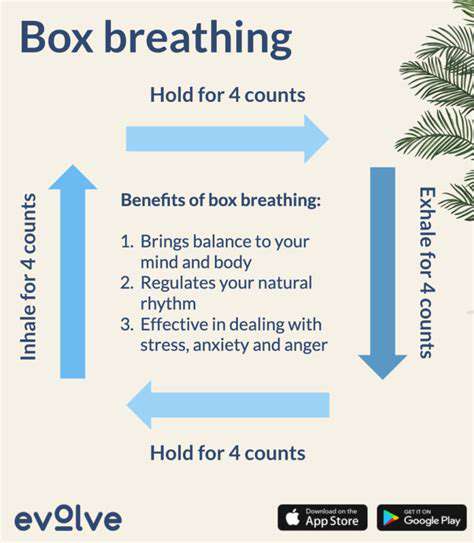Effective Breathing Strategies for Managing Panic Attacks

Understanding the Fundamentals of Box Breathing
Box breathing, sometimes called square breathing, is a straightforward yet remarkably effective method to enhance both physical and mental health. This technique follows a specific sequence of inhaling, holding, exhaling, and pausing, creating a steady and deliberate rhythm. Athletes frequently employ this method to combat stress, sharpen focus, and maintain composure under pressure. With regular practice, individuals can experience a wide array of benefits that contribute to overall wellness.
At its heart, box breathing works by influencing the autonomic nervous system. When you slow and deepen your breaths, you engage the parasympathetic nervous system, which counteracts stress by lowering cortisol levels. This physiological shift can quiet the mind, reduce heart rate, and foster a profound sense of tranquility. It’s a practical tool for anyone seeking relief from anxiety or a moment of calm in a hectic day.
Implementing the Box Breathing Technique
To begin, settle into a comfortable position—either seated or lying down—and close your eyes. Focus entirely on your breath as you follow these steps: Inhale gently through your nose for four seconds. Hold the breath for another four seconds. Exhale smoothly through your mouth for four seconds. Pause again for four seconds before repeating the cycle. Aim to continue this pattern for several minutes to maximize its effects.
The structured rhythm of box breathing provides a grounding effect, anchoring the mind and body in the present moment. Over time, consistent practice can lead to noticeable improvements in mental clarity and emotional stability. By interrupting the cycle of racing thoughts, this technique offers a reliable way to restore balance during stressful situations, whether at work or in personal life.
Benefits and Applications of Box Breathing
The advantages of box breathing extend well beyond stress relief. It sharpens focus by minimizing distractions, making it invaluable for students, professionals, or anyone needing to concentrate. The technique’s simplicity belies its profound impact on daily challenges, offering a quick reset button for the mind.
On a physical level, box breathing enhances performance by optimizing oxygen flow and reducing muscle fatigue. Athletes, performers, and individuals engaged in demanding tasks can all benefit from this practice. Its versatility makes it a cornerstone of holistic well-being, bridging the gap between mental and physical health.
For those managing chronic conditions like anxiety or asthma, box breathing provides a structured way to regulate breathing patterns. Incorporating it into a daily routine can lead to lasting improvements in stress management and emotional resilience, proving its worth as a foundational self-care strategy.
Progressive Muscle Relaxation and Breathing: Combining Techniques for Enhanced Calm
Understanding Progressive Muscle Relaxation
Progressive muscle relaxation (PMR) is a method that involves alternately tensing and releasing muscle groups throughout the body. This practice helps identify areas of tension, often linked to stress or anxiety. By focusing on the contrast between tension and relaxation, individuals gain greater awareness of their body’s responses to stress, fostering a deeper mind-body connection.
The underlying idea of PMR is simple: physical tension mirrors mental strain. Releasing tight muscles can alleviate emotional stress, making this technique especially useful for those with chronic tension, anxiety, or sleep difficulties. It’s a tangible way to address the physical manifestations of stress.
The Role of Breathing in Stress Management
Intentional breathing is a cornerstone of stress reduction. Slow, deep breaths activate the parasympathetic nervous system, which counters the body’s stress response. This shift promotes relaxation by stabilizing heart rate, blood pressure, and other physiological markers of tension.
Techniques like box breathing or diaphragmatic breathing can be paired with PMR to amplify relaxation. Focusing on breath rhythm enhances the body’s natural ability to unwind, creating a more profound sense of calm.
Combining PMR and Breathing for Enhanced Calm
When PMR and controlled breathing are used together, they create a synergistic effect. The physical release from PMR complements the mental clarity fostered by mindful breathing, offering a comprehensive approach to stress relief. This dual method addresses both the body and mind, leading to deeper relaxation.
Practical Application of Combined Techniques
To practice, find a quiet space without distractions. Begin by tensing and relaxing muscle groups one at a time, synchronizing each release with slow, deliberate breaths. Consistency is crucial—regular practice deepens the benefits and makes the techniques more effective over time.
Always prioritize comfort. If any movement or breath pattern feels strained, pause and adjust. Consulting a healthcare provider is advisable if discomfort persists.
Addressing Specific Stressors through Combined Techniques
This combination is adaptable to various stressors. For instance, public speaking anxiety can be eased by relaxing tense shoulders and jaws while using breath control to steady nerves. Similarly, workplace stress can be managed by incorporating these techniques into short breaks, creating moments of calm amid chaos.
Long-Term Benefits and Maintenance
Regular use of PMR and breathing exercises yields lasting benefits, including lower stress levels, better sleep, and improved emotional regulation. Making these practices a habit—even in small doses—builds resilience over time. They’re not just crisis tools but proactive strategies for sustained well-being.
Cultivating mindfulness through these techniques fosters a balanced, resilient approach to life’s challenges.
